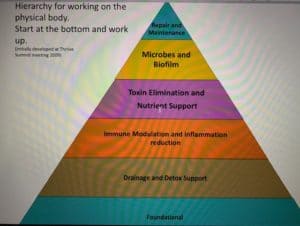Autoimmune Disease and Lyme Disease in AZ
 Lyme disease starts as an acute infection with the Borrelia bacteria. If caught, a patient will get IV or oral antibiotics. Many times the acute infection (rash, possibly slight fever) goes unnoticed and the patient may later develop the sequela of Lyme. Genetic weakness, stress, poor diet, long term use of antibiotics, mold and latent viral infections all contribute to a weak immune system. Not all patients who were once infected by a tick will develop autoimmune disease. But with the right combination of factors at the wrong time, an autoimmune condition may develop months to years after the initial infection.
Lyme disease starts as an acute infection with the Borrelia bacteria. If caught, a patient will get IV or oral antibiotics. Many times the acute infection (rash, possibly slight fever) goes unnoticed and the patient may later develop the sequela of Lyme. Genetic weakness, stress, poor diet, long term use of antibiotics, mold and latent viral infections all contribute to a weak immune system. Not all patients who were once infected by a tick will develop autoimmune disease. But with the right combination of factors at the wrong time, an autoimmune condition may develop months to years after the initial infection.
Once the acute infection has resolved and the patient has developed autoimmune disease, it is no longer effective to treat the “Lyme” with antibiotics, even though the labs show positive for Borellia. Most of the time, the patient now has co-infections which can be tested in specialty labs. These include Babesia, Bartonella, Mycoplasma, virus Herpes, 6,1, 2, EBV and CMV, parasites, fungus. The toughest thing about treating these infections is the biofilm that is created to protect the microbes from the host’s immune system. As a result of microbes and inflammatory triggers, the immune system mounts a never ending response that results in a condition called CIRS (chronic immune response syndrome).
The pyramid above illustrates how complex the treatment needs to be. First the inflammatory cycle and the immune system need to be brought back into control. Pathways of elimination need to be opened and the nutrient status of the patient should be high before beginning anti-microbial therapy.
Anti-microbial therapy is two-fold. Both broad spectrum anti-microbial herbs and supplements which facilitate the immune system’s own response should be used. Often times the physician jumps to using the anti-microbial herbs without addressing the inflammatory cycle or the innate immune system of the patient. The biofilm must also be addressed for the anti-microbials to be effective. This is addressed with specific enzymes that can digest the film, exposing the infectious antigens to the herbs and the immune system.
There are many ways to address the inflammatory cycle and immune system. Nutrients such as Curcumin, Vitamins A & D, and essential fatty acids all serve as ways to help the immune system come back into balance. In addition, genetic testing may show the patient is deficient in NADH which is critical to many processes that have to do with oxidative stress. Knowing this gives the physician another tool in helping the immune system to work better.
Unfortunately, patients with Lyme disease become discouraged and feel that their condition is untreatable. So it is imperative that the treatment be multi-factorial and not just focused and killing the bugs. In summary, the good physician always respects the power of the immune system and works with it in the treatment protocols by addressing it’s over-activity, while facilitating a healthy response to pathogens. In this way the anti-microbial agents that are used will be much more effective in resolving the illness.
For more information call 480-535-7868 or requst an appointment
